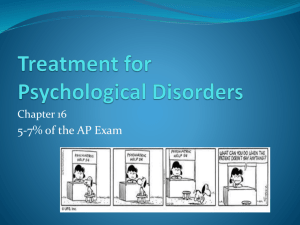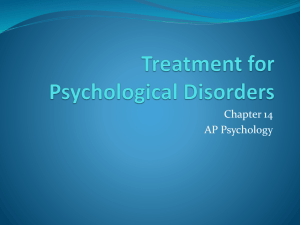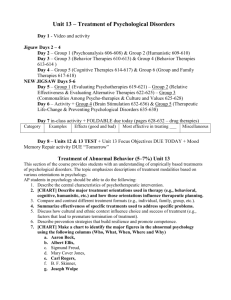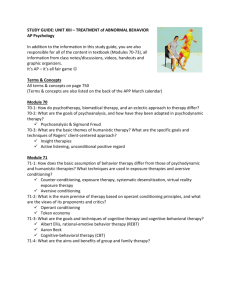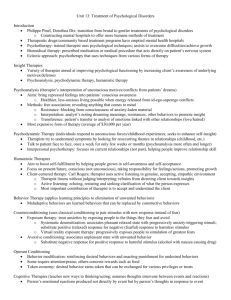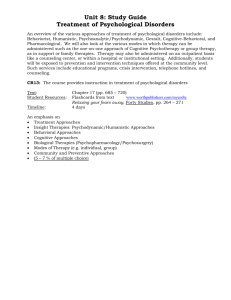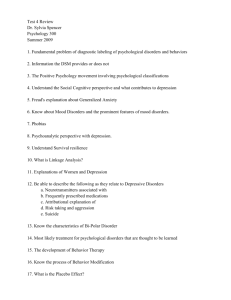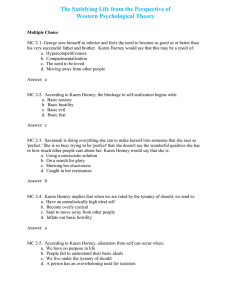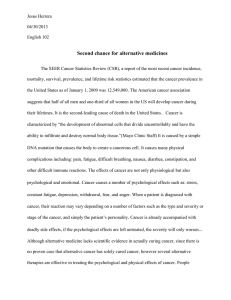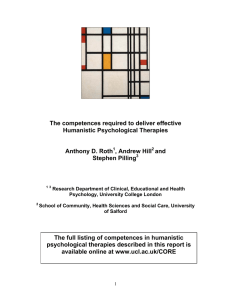Treatment for Psychological Disorders
advertisement
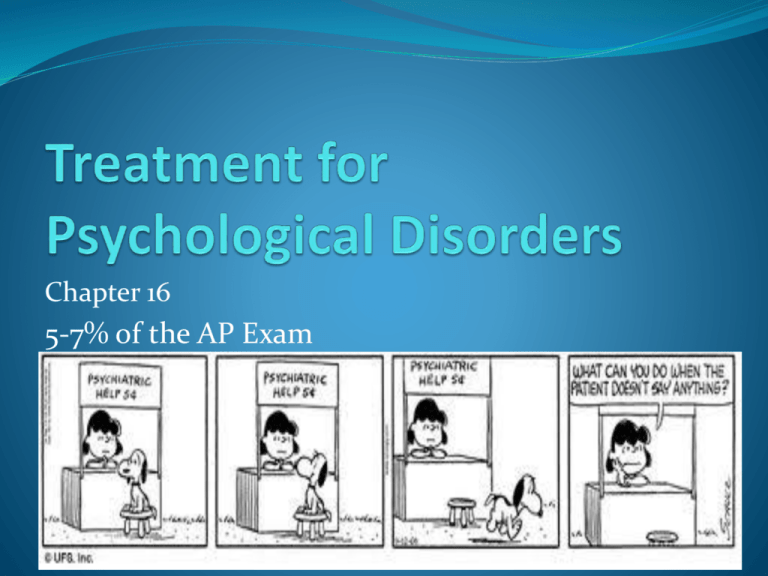
Chapter 16 5-7% of the AP Exam Psychological Treatment When a psychological disorder becomes serious enough to cause problems in everyday functioning, the client may seek to have the disorder treated. Psychotherapy – An Overview The treatment of disorders through psychological methods Clients Inpatient Outpatient Treatment from Psychiatrists Psychologists Counselor Medical Doctor Basic goal = help people change their way of thinking, feeling, and/or behavior Psychodynamic Psychotherapy Psychoanalysis – understanding unconscious conflicts Freud’s one-on-one method Aims to help clients gain insight into and work through problems Other psychoanalytic therapies Contemporary Psychoanalysis = less emphasis on Freud’s “unconscious impulses” All seek to understand the patient’s past to help understand the future Help client function in everyday life Carl Jung Karen Horney Humanistic Psychotherapy Emphasize the way in which people interpret the events in their lives behavior = motivated by an innate drive toward growth Clients (not patients) will improve on their own, given the right conditions Patients must feel equal, accepted, and supported Emphasis on free-will of client Humanistic Client-Centered Therapy Carl Rogers nondirective therapy allow clients to decide what to talk about and when Genuineness- completely honest and open Unconditional Positive Regard- fully accepting the worth of the client Empathy- emotional understanding Other humanistic therapies Group and Family therapies emphasis placed on growth of the individual Group Therapy – simultaneous treatment of several clients – no single theoretical approach used allows interaction clients feel less alone boost each other’s confidence more willing to share Family & Couples Therapy – treatment of two or more from same family system – goal is to create harmony and balance Gestalt Therapy Fritz and Laura Perls perspective that people create their own understanding of the world continue to grow as long as they have insight into their feelings Help clients see inconsistencies between how clients see themselves and how they act in the world “You cannot achieve happiness. Happiness happens and is a transitory stage. Imagine how happy I felt when I got relief from bladder pressure. How long did that happiness last?” (Fritz Perls) “Lose your mind and come to your senses.” (Fritz Perls) Behavior Therapy Clients see their problems as learned behaviors that can be changed (without searching for hidden meanings or unconscious causes) Based on the work of Watson, Pavlov, & Skinner Features: Development of a productive therapist-client relationship Careful listing of the behaviors and thoughts to be changed – assessment and establishment of goals Learning-based treatments – giving “homework” Continuous monitoring and evaluation of treatment Behavior Therapy (con’t) Behavior Therapy – classical conditioning Behavior Modification – operant conditioning Cognitive-behavior therapy – altering both thinking patterns and behavior Techniques for Modifying Behavior Systematic Desensitization Visualization then progressive relaxation Modeling Training in assertiveness and social skills Positive reinforcement Token economy—desirable behaviors are positively reinforced Extinction Flooding-continuous exposure to feared stimuli Aversive Conditioning associate behavior with negative experience Rational Emotive Behavioral Therapy (REBT) Albert Ellis People engage in self-talk that is false If they can change their beliefs, this will produce a change in emotion Therapist confront irrational (illogical, maladaptive) beliefs and teaches client to create a realistic perspective Beck’s Cognitive Therapy (for depression) Aaron Beck Widely used for depression Cognitive schemas, methods for organizing the way we view the world, have evolved into a distorted perception Therapist draws attention to faulty reasoning, challenges validity of statements Helps change way of thinking using assignments to see cognitive schema Biological Treatments Electroconvulsive Therapy (ECT) – “shock treatment” Early use – physicians passed electric currents through brains of people with schizophrenia Modern use – shock is applied to one side of the brain at a time – used to treat patients with severe depression, who do not respond well to medication Still controversial Psychosurgery – destruction of brain tissue for treating mental disorders Prefrontal lobotomy—cut connections from prefrontal cortex to rest of brain Biological Treatments Psychoactive Drugs (con’t) Neuroleptics (Antipsychotics)– reduce psychotic symptoms such as hallucinations, delusions, paranoia, & disordered thinking Antidepressants – help relieve symptoms of depression – immediate effect on neurotransmitters increasing serotonin or norepinephrine Lithium –reduce frequency and intensity of manic and depressive phases of bipolar patients Anxiolytics (tranquilizers) – treats anxiety most widely prescribed and used of all legal drugs Evaluating Psychoactive Drug Treatments Limitations – Drugs may cover up the problem without permanently curing it Relieve symptoms without addressing underlying causes Drug abuse – physical and psychological dependence Side effects Effectiveness of Treatment https://www.ted.com/talks/david_anderson_your_brai n_is_more_than_a_bag_of_chemicals?language=en
